| << Chapter < Page | Chapter >> Page > |
Solve:
|
| |
| Simplify each side of the equation as much as possible by distributing.
The only term is on the left side, so all variable terms are on the left side of the equation. |
|
| Add 5 to both sides to get all constant terms on the right side of the equation. |
|
| Simplify. |
|
| Make the coefficient of the variable term equal to 1 by multiplying both sides by -1. |
|
| Simplify. |
|
| Check: Let . | |
|
|
Solve:
|
| |
| Simplify each side of the equation as much as possible.
Distribute. |
|
| Combine like terms |
|
| The only is on the left side, so all variable terms are on one side of the equation. | |
| Add 3 to both sides to get all constant terms on the other side of the equation. |
|
| Simplify. |
|
| Make the coefficient of the variable term equal to 1 by dividing both sides by 4. |
|
| Simplify. |
|
| Check: Let . | |
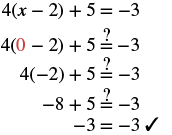 |
Solve:
Be careful when distributing the negative.
|
| |
| Simplify—use the Distributive Property. |
|
| Combine like terms. |
|
| Add 2 to both sides to collect constants on the right. |
|
| Simplify. |
|
| Divide both sides by −6. |
|
| Simplify. |
|
| Check: Let . | |
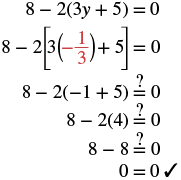 |
Solve:
|
| |
| Distribute. |
|
| Combine like terms. |
|
| Subtract to get all the variables on the right since . |
|
| Simplify. |
|
| Subtract 9 to get the constants on the left. |
|
| Simplify. |
|
| Divide by 5. |
|
| Simplify. |
|
| Check: Substitute: . | |
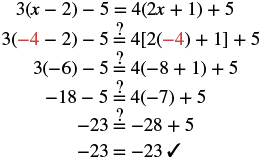 |
Solve:
|
| |
| Distribute. |
|
| Add to get all the variables on the left. |
|
| Simplify. |
|
| Add 1 to get constants on the right. |
|
| Simplify. |
|
| Divide by 4. |
|
| Simplify. |
|
| Check: Let . | |
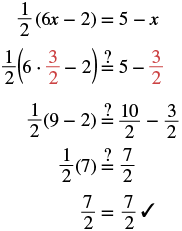 |
In many applications, we will have to solve equations with decimals. The same general strategy will work for these equations.
Solve:
|
| |
| Distribute. |
|
| Subtract to get all the s to the left. |
|
| Simplify. |
|
| Subtract 1.2 to get the constants to the right. |
|
| Simplify. |
|
| Divide. |
|
| Simplify. |
|
| Check: Let . | |
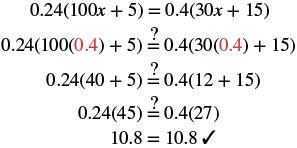 |

Notification Switch
Would you like to follow the 'Prealgebra' conversation and receive update notifications?